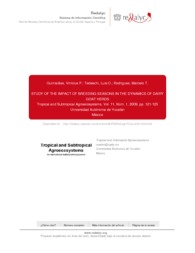Study of the impact of breeding seasons in the dynamics of dairy goat herds.
Study of the impact of breeding seasons in the dynamics of dairy goat herds.
Author(s): GUIMARÃES, V. P.; TEDESCHI, L. O.; RODRIGUES, M. T.
Summary: Abstract: The competitiveness in the animal production field has forced the smaller activities to be more efficient when compared to big business of the agro-industries. The dairy goat production is one of those market niches that need a better understand of its sector. For those reasons it has been proposed that by changing the number of reproduction seasons would increase income of the producers. The objectives of this study were to evaluate the impact of 1 or 2 annual reproductive cycles on production and economical health of dairy goats and to identify differences of production costs and revenues associated with changes in the herd dynamics as predicted by a mathematical model. A previously developed goat model using the System Dynamics approach to study long-term changes in the dynamics of the herd was used in these simulations. The model simulations used feeds, labor, and fixed costs as inputs and the outputs were revenues from milk production sales and sales of animals from all categories of the herd. The simulation time unit was ?month? and a long-term horizon of 10 years was considered for these simulations. The model was set up to simulate a freestall facility of a herd in equilibrium with 100 does in lactation. All parameters considered in this model assumed average values reported in production systems in the Southeast region of Brazil. The simulations results indicated that improvements of 10% in the fertility rate would increase the number animals in the herd up to 185% and 35% for one and two breeding season, respectively. Establishing a milk price as US$0.68 the break even for one and two breeding seasons was respectively US$0.62, and US$0.50, giving the systems with two breeding a capacity to support reductions on milk price up to 26% against 9% with one breeding season. When comparing the models with 1 or 2 breeding seasons was found that models with 2 breeding seasons was considerably more profitable and had a higher turnover than the model with 1 breeding season. The results indicate that the use of a second (artificial) breeding season might be an important management strategy to improve the efficiency of the dairy goat production systems. [Estudio del impacto de la estación reproductiva sobre la dinâmica de los rebaños lecheros].
Publication year: 2009
Types of publication: Journal article
Unit: Embrapa Goats & Sheep
Keywords: Brazil, Breeding, Cabra leiteira, Caprino leiteiro, Farm models, Goats, Modelo animal, Sistema de produção
Observation
Some of Embrapa's publications are published as ePub files. To read them, use or download one of the following free software options to your computer or mobile device. Android: Google Play Books; IOS: iBooks; Windows and Linux: Calibre.
Access other publications
Access the Agricultural Research Database (BDPA) to consult Embrapa's full library collection and records.
Visit Embrapa Bookstore to purchase books and other publications sold by Embrapa.

